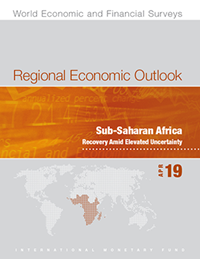
Sub-Saharan Africa
Sub-Saharan Africa Regional Economic Outlook: Recovery Amid Elevated Uncertainty
April 2019
Full Text Country Focus Podcast
Background Paper and
Expanded
Statistical Appendix Tables
The economic recovery in sub-Saharan Africa continues. Regional growth is set to pick up from 3 percent in 2018 to 3.5 percent in 2019, before stabilizing at close to 4 percent over the medium term. These region‑wide numbers mask considerable differences in the growth performance and prospects of countries across the region. About half of the region’s countries— mostly non-resource-intensive countries—are expected to grow at 5 percent or more, which would see per capita incomes rise faster than the rest of the world on average over the medium term. For all other countries, mostly resource-intensive countries, improvements in living standards will be slower. Notwithstanding these different economic prospects and policy priorities, countries share the challenge of strengthening resilience and creating higher, more inclusive and durable growth. Addressing these challenges requires building fiscal space and enhancing resilience to shocks by stepping up actions to mobilize revenues, alongside policies to boost productivity and private investment.
Executive Summary
The economic recovery in sub-Saharan Africa continues, but there is duality in growth performance and prospects within the region. Aggregate growth is set to pick up from 3 percent in 2018 to 3.5 percent in 2019 and stabilize at slightly below 4 percent over the medium term—or about 5 percent, excluding the two major economies, Nigeria and South Africa.
Chapter 1 - Two-Track Recovery Amid Elevated Uncertainty
DownloadEconomic recovery in sub-Saharan Africa is set to continue with growth projected to pick up from 3 percent in 2018 to 3.5 percent in 2019.
But economic performance remains bifurcated.
Chapter 2 - The Economic Consequences of Conflicts
DownloadArmed conflict in its various forms and manifestations remains pervasive around the world. In sub-Saharan Africa, while a declining trend was observed in the incidence and intensity of conflicts since the early 2000s, there has been an uptick in violence in recent years that mirrors the global increase in conflict. Overall, about a third of the countries in the region have been affected by conflict in recent years.
Chapter 3 - Is the African Continental Free Trade Area a Game Changer for the Continent?
DownloadIn 2018, member countries of the African Union took a major step to boost regional trade and economic integration by establishing the African Continental Free Trade Area (AfCFTA). They agreed to eliminate tariffs on most goods, liberalize trade of key services, address nontariff obstacles to intraregional trade, and eventually create a continental single market with free movement of labor and capital. The AfCFTA has been ratified by 22 countries and is likely to take effect in 2019, although negotiations on specific features of the agreement are ongoing. Once operational, the AfCFTA will establish a market of 1.2 billion people with a combined GDP of US$2.5 trillion. This could be an economic game changer for the continent.


